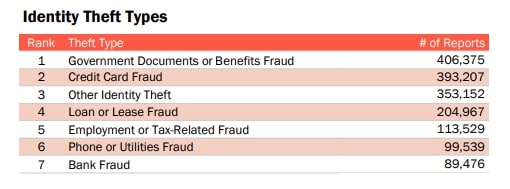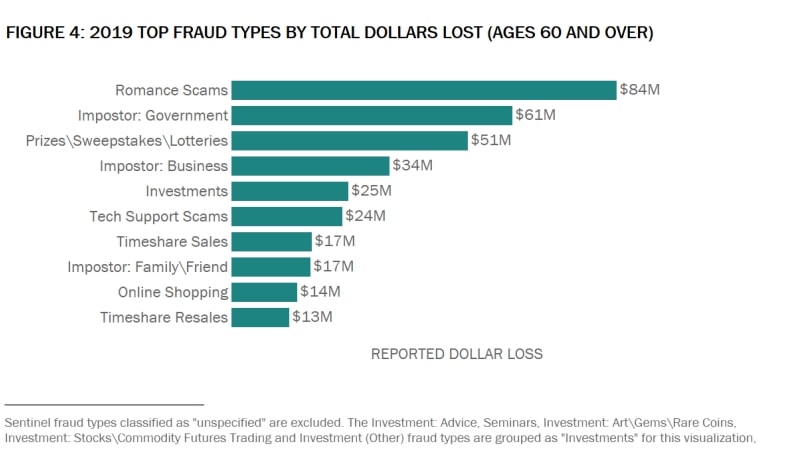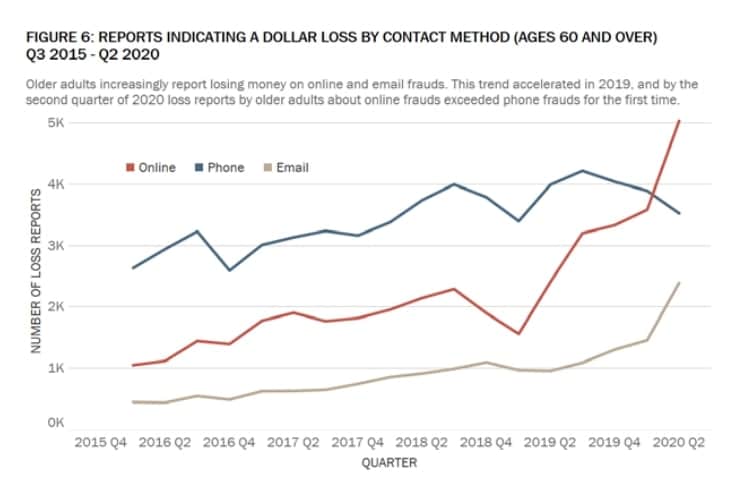
Statistics show that an increasing number of people are falling victim to scams. Part of the problem is that scammers are highly adaptable and can mimic legitimate communications from romantic partners, tech support staff, and government employees. One group particularly affected by this issue is the elderly. Those homeowners with healthy financial savings, good credit scores, and a trusting nature often prove to be attractive targets for scammers.
Below, we’ve compiled a selection of senior scam statistics which help paint a picture of the growing problem:
1. There was a 47% increase in fraud and identity theft reports from 2019 to 2020
Every year, the FTC publishes its Consumer Sentinel Network Data Book — a compilation of statistics stored in a secure online database that’s available only to law enforcement. In 2001, the first year of reporting, there were 325,000 reports. By 2019, this number had risen to 3.24 million. However, the biggest one-year increase took place between 2019 and 2020 when that number rose to 4.7 million (a staggering 47%).
2. Seniors lost more than $3 billion in 2020 to financial scams
The FBI estimates that senior citizens lose more than $3 billion each year to financial scams including romance scams and lottery and sweepstakes scams. This is backed up by the CSN Data Book 2020 which states that people reported losses of more than $3.3 billion to fraud in 2020 — an increase of nearly $1.5 billion over 2019. As the world’s population continues to age, this number is only likely to rise.
3. Fraud and identity theft make up the most common report types
Fraud (46.3%) and identity theft (29.4%) make up the majority of reports received by the FTC. When it comes to fraud, imposter scams are the most common report type with nearly 500,000 in total. These totaled losses of almost $1.2 billion with a median loss of $850. With over 400,000 reported cases, “Government documents or benefits fraud” was the most common type of identity theft.
4. Senior citizens are less likely to report losing money to fraud
According to the FBI, senior citizens are less likely to report fraud. This is supported by figures from the FTC which show that while 44% of younger people aged 20–29 reported losing money to fraud, only 20% of older people ages 70–79 did the same. The FBI speculates that this may be due to a lack of understanding of the reporting process. It goes on to suggest that shame and fear of losing financial independence may also be at play.
5. The median loss is much higher for ages 70 and over
While the percentage of those reporting fraud losses decreases among the older age groups, the median losses trend in the other direction. Those aged 20–29 had an average loss of $324 in 2020. For 60–69 year-olds, this number rose to $426, while ages 70-79 suffered a median loss of $635. However, it was ages 80 and upwards that were the worst affected. In this case, the median loss was $1,300 (a nearly 105% increase over the nearest age group).
6. Government Documents or Benefits Fraud are the most common identity theft type for ages 60 and over
The most common identity theft type for persons aged 60 and over was government documents or benefits fraud. This percentage was highest among those aged 60–69 (46%). While it was also the most common type for most other age groups such as 70–79-year-olds and 80 and over, the respective percentages were lower at 38% and 25%.
7. Older adults are six times more likely to report losing money on a tech support scam
Despite being less likely to report fraud overall, the FTC’s Protecting Older Consumers report (2019–2020) found that adults over 60 are more likely to report financial losses to certain types of frauds. In particular, older adults are nearly six times more likely (474%) than younger consumers to report losing money due to a tech support scam. They’re also three times more likely to report losses on prize, sweepstakes, or lottery scams.
8. Online shopping fraud is the most common way senior citizens lose money
Fewer older adults report losing money to online shopping fraud than young consumers. Despite this, online shopping surpassed tech support in 2019 as the top fraud type older consumers lose money to. This rise accelerated during the COVID-19 pandemic in which more people purchased online than ever. The reported average loss to online shopping fraud suffered by seniors is $129.
9. Romance scams resulted in the heaviest losses for the over 60s
For those aged 60 and over, the highest aggregate losses reported in 2019 were in the romance scam category. Indeed, aggregate losses totalled nearly $84 million. This was followed by government imposter scams ($61 million) and then the prizes, sweepstakes, and lottery category, which accounted for $51 million in aggregate dollar losses.
10. Older adults report that scammers most commonly contact them over the phone
The FTC reported that the phone was the top fraud contact method reported by the elderly, with 16,000 reports. The second most common was online, with 10,000 reports. Older adults reported significantly higher losses and higher median individual losses ($1,500) on phone scams than younger consumers. This was particularly the case for those aged 80 and over which reported median individual losses of $3,500 from phone scams — four times of those reported by adults aged 20-59.
11. Online contact methods are increasingly used to defraud the elderly
The COVID-19 pandemic saw online contact methods such as email and social media used more frequently by scammers. Indeed, the number of loss reports indicating that social media was the contact method increased from 289 in Q1 2019 to 967 in Q2 2020. By the second quarter of 2020, senior citizens were making more loss reports about online frauds than phone frauds for the first time.
12. Gift cards have become the payment method of choice for scammers
Older adults most often reported paying fraudsters with gift cards and reload cards (28.4% of cases). This has shown a steady increase since 2018. However, credit card payments remain just as common (27.7% of cases). Despite this, the over 60s sent far more money by wire transfer than any other method. The total amount paid by wire transfer was $142 million with a median individual loss of $6,000 (again higher than any other payment method).
13. Most older consumers who filed reports avoided losing money
The pattern in Sentinel fraud reports in recent years has been that the majority of consumers age 60 or older who filed reports didn’t indicate any monetary loss. Statistics show that older adults are 64% more likely to file a no-loss fraud report than consumers aged between 20 and 59.
14. California was the most affected state with over 12,000 over 60 victims
According to the FBI’s Elder Fraud Report 2020, California had more victims over the age of 60 than any other state. Overall, there were some 12,534 complaints coming from The Golden State. The second and third highest were Florida and Texas at 9,252 and 6,342 respectively. The highest losses were in California with over 60s losing over $152 million.
See also:
L’article Senior scam statistics 2021 est apparu en premier sur Comparitech.





0 Commentaires